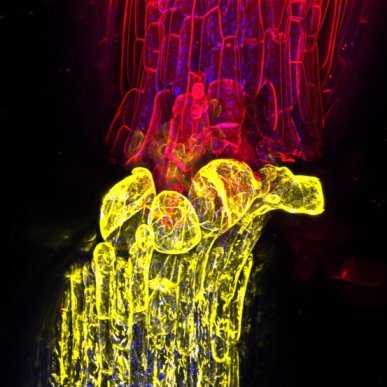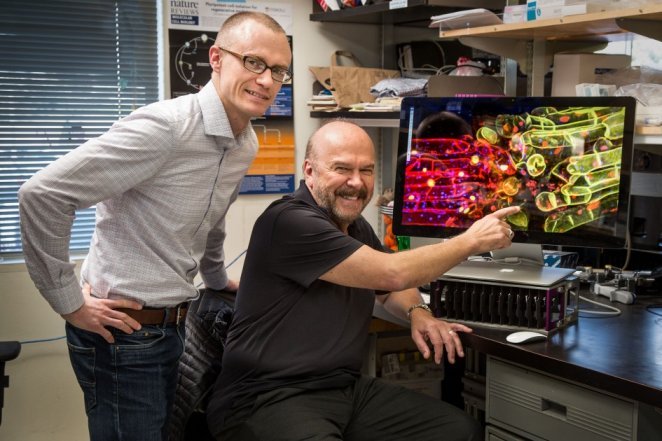«Grafting is something done often in the commercial world, and yet, we really don’t completely understand the consequences for the two plants," says Joseph Ecker, one of the senior authors of the paper and director of Salk’s Genomic Analysis Laboratory. «Our study showed genetic information is actually flowing from one plant to the other. That’s the surprise to me.»
That genetic information shared between plants isn’t
 In epigenetics, chemical markers act on existing genes in a plant or animal’s DNA to turn genes on or off. Epigenetics can determine whether a cell becomes muscle cell or a skin cell and determine how a plant reacts to different soils, climates and disease.
In epigenetics, chemical markers act on existing genes in a plant or animal’s DNA to turn genes on or off. Epigenetics can determine whether a cell becomes muscle cell or a skin cell and determine how a plant reacts to different soils, climates and disease.
«In the future, this research might allow growers to exploit epigenetic information to improve crops and yields," says Mathew Lewsey, one of the first authors of the paper and a Salk research associate.
To track the flow of epigenetic information, the Salk and Cambridge teams focused on tiny molecules called small RNAs, or sRNAs. There are various types of epigenetic processes, but sRNAs contribute to a gene silencing process called DNA methylation. In DNA methylation, molecular markers bind along the top of DNA to block the cell’s machinery from reading or expressing the genes under the molecular markers.
Previous studies by the Cambridge members of this research group have shown that sRNAs can move across grafted plants from the shoots to the roots. So the researchers designed a grafting experiment with three variations of the plant Arabidopsis thaliana (thale cress). Two varieties were
After performing each graft, the researchers analyzed shoot and root tissue to look for changes in DNA methylation along the plants’ different genomes. They also confirmed whether the sRNAs were moving from the
«This
An allele is a gene that is shared within a species, but may differ from individual to individual, such as the allele for developing Huntington’s disease. In this case, the researchers were searching for sites along the epigenome of the plants that were alleles altered by the epigenetic process. In other words: epialleles.
«Because the two
David Baulcombe, a senior author on the paper, acknowledges that the new findings were not totally unexpected. Previous smaller scale work had indicated that sRNAs could move and mediate epigenetic change in the recipient tissue.
«What was unexpected, however, was the scale of the changes due to the mobile RNA," says Baulcombe, of the Department of Plant Sciences at the University of Cambridge.
Thousands of sites along the thale cress genome were silenced by sRNAs. By examining the location of these epialleles, the researchers could start to find clues to their purpose. The epialleles observed in the experiment were often silencing areas of the genome called transposable elements, or transposons.
Transposons make up part of the

Despite this silencing of transposons, there were only small changes in gene expression between the
«We think this is because of the compact nature of the A. thaliana genome," says Lewsey. «It’s likely that moving to a species with a larger genome and transposons that are more active will show more of a difference.»
Thanks to new gene editing tools, it will be possible to run similar grafting experiments with the more complicated genomes of popular crops.
«In other plants with more complex genomes, these effects are going to be magnified by many
Baulcombe agrees that the epigenetic effects of the mobile RNA are likely to be much greater with crop plants than in the models species used in the present work. The two research groups are now planning an extended collaboration to explore these effects in tomatoes and other crops.
«There are already thousands of other epigenetic differences between the roots and the shoots of a single
Lewsey and Thomas J. Hardcastle of the University of Cambridge contributed equally to the paper. Other authors of the work were Charles Melnyk and Attila Molnar of the University of Cambridge; and Adrián Valli, Mark A. Urich and Joseph R. Nery of the Salk Institute.
Funding for the work was provided by the EU Marie Curie International Outgoing Fellowship, the Gordon and Betty Moore Foundation, the National Science Foundation, the Clare College Junior Research Fellowship, the Gatsby Charitable Foundation, the European Union Collaborative Project Grant ANEAS and a European Research Council Advanced Investigator Grant.
Source: http://www.salk.edu/news-release/grafted-plants-genomes-can-communicate-with-each-other/


